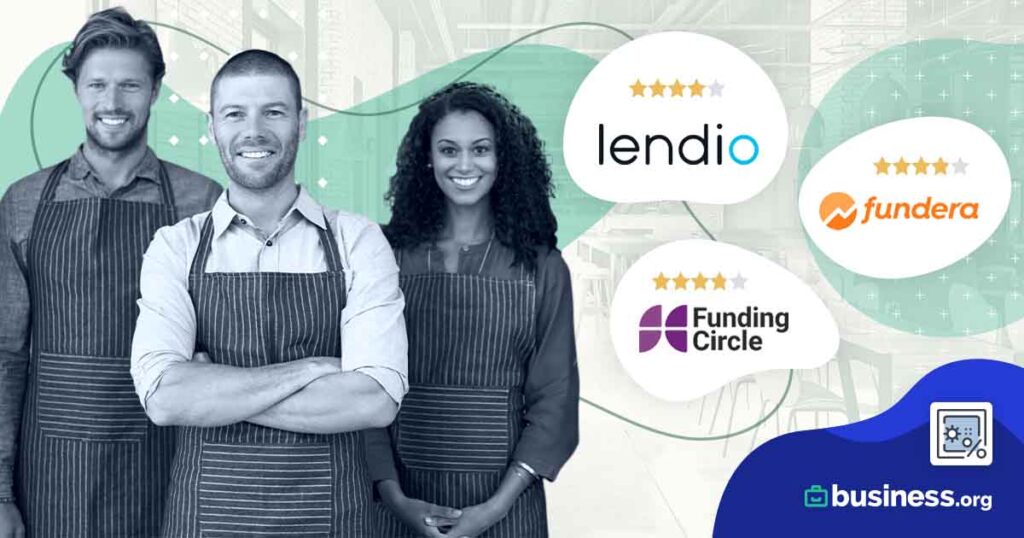We are committed to sharing unbiased reviews. Some of the links on our site are from our partners who compensate us. Read our editorial guidelines and advertising disclosure.
How to Get an SBA Loan
SBA loans, or loans backed by the US Small Business Administration (SBA), offer affordable interest rates and generous repayment terms. Even better, they’re designed to help business owners who might not be able to get traditional bank loans.
So how do you get them? Where do you apply? And how long does it take?
We’ll answer these questions (and plenty more) as we walk you through the process of getting an SBA small business loan.
Want an economic injury disaster loan or other SBA disaster loan? Those work a little differently than other types of SBA loans, so we’ve given them their own special section.
1. Figure out if you'll qualify for an SBA loan
Just like any other type of business loan, SBA loans come with certain borrower qualifications. You’ll have to meet or exceed those qualifications to get approved.
Now, the SBA itself doesn’t have particularly strict borrower qualifications. For example, its eligibility requirements for applicants include the following:
- Run a for-profit business
- Conduct business in the United States (or its territories)
- Have some equity/ownership in the business
- Use other funding sources (like your own money) before getting a loan
Nothing too difficult, right?
Well, you need to remember that the SBA doesn’t actually extend loans―it just backs loans made by lenders. And those lenders tend to have a lot more borrower requirements.
For example, most lenders will want to see that you have a personal credit score of at least 640, and some will look for a higher score. Likewise, lenders will usually look for businesses that are at least two years old (so no brand-new startups). They’ll probably also want to make sure that you haven’t had any recent bankruptcies or foreclosures, and they have other requirements as well.
That means that if you have bad credit or a very young business, you probably won’t qualify for an SBA loan. (But we’ve found some bad-credit loans for startups that might interest you.)
But if none of the SBA loan requirements above phase you, then you’re ready to start narrowing down your loan choices.
By signing up I agree to the Terms of Use.
2. Decide what kind of SBA loan you want
There are actually several types of SBA loans that you can choose from. To narrow down your choices, you’ll want to think about a few factors:
- How much money you need
- How you plan to use the funds
- How quickly you need the loan
If you want a basic working capital loan and you’re not in a hurry, for example, you’ll probably just want to stick to an SBA 7(a) loan. If you need less money but you need it fast, an SBA Express loan might be more your speed. And if you’re planning an intensive real estate project, you may want an SBA 504 loan.
Types of SBA loans
Your preferred type of SBA loan will also affect which lenders you can work with (since not all lenders offer all types of SBA loans). So once you’ve got a loan type in mind, you’re ready to start looking at lenders.
3. Find an SBA lending partner
So here’s a fun (and important) fact you may not know about SBA loans: You don’t submit an application to the SBA itself. (Disaster loans are the exception, and we’ll cover those in a bit.) Instead, you’ll apply to a lender that partners with the SBA.
This lender will be the one that actually funds your loan―which means it’s the lender you’ll deal with all throughout your loan application, funding, and repayment process. In other words, you’ll want to choose a lender you like.
As you’re choosing your SBA lender, you can ask potential lenders some questions to help you find a good fit:
- What fees do they charge on SBA loans?
- What are their minimum credit score requirements?
- What other borrower requirements do they have?
- How long does their SBA loan process usually take?
The SBA partners with a lot of lenders, so you’ll have quite a few options. For example, most big banks (like Wells Fargo, Chase, and others) extend SBA loans. Tons of smaller banks have them too. Even your local credit union might offer SBA loans.
If you’re not sure where to start, the SBA website has a lender match tool to help you find one. Or you can apply with one of our recommended lending companies: SmartBiz or Lendio.
Once you’ve found a lender you like, you can work on your loan application.
4. Submit your SBA loan application
Your lender should guide you through the SBA loan application process. They know about all the documents you need to submit, for example, and they’ll pass that information along to you.
While your specific documentation needs may be different, you should expect to need these:
- Personal tax returns
- Business tax returns
- Articles of incorporation
- Business license
- Lease agreements
- Profit & loss statement
- Balance sheet
- Other financial statements
And you might end up needing a lot more than that.
In any case, you’ll want to get those documents (or whatever else your lender asks for) in as soon as possible.
See, the SBA loan application process notoriously takes a long time. But a lot of that time comes down to how long it takes the business owner to produce all the necessary documents. That means that you can speed up your application time a lot by being prepared and then being responsive.
Once your lender has everything they need, it will submit your application to the SBA for approval. Depending on your loan type, the SBA will turnaround your application sometime between 36 hours and 10 days. (Our guide to business loan timelines explains more.)
If all goes well, your SBA loan application will get approved, and you’ll be on your way to getting funded.
5. Use and repay your SBA loan
After you’re approved, you’ll still need to wait for your money. Your lender can take anywhere from a few days to a few weeks to fund your loan (which is why we encourage you to ask about typical timelines before settling on a lender).
One way or another, you’ll get your money and be able to use it. Congrats!
Of course, after you get your loan proceeds, you’ll start repaying your SBA loan. In most cases, this means a monthly payment.
Make sure you understand your payment terms. If you have an SBA Express loan, for example, you may end up with a balloon payment (a large balance due at the end of your term) you need to prepare for. Or if you want to repay your SBA loan before the term is up, you may get hit with a prepayment penalty. In other words, do your homework to keep from getting hit with a nasty surprise.
And this should go without saying, but make sure you make all your payments and that you make them on time. Repaying your loan on schedule can help your credit score and your chances of getting future funding (whether through SBA loans or not), while failing to repay your loan will have the opposite effect. So pay your loan.
SBA disaster loans
We mentioned already that SBA disaster loans don’t work quite like other types of SBA loans. But what does that mean?
Qualifying for an SBA disaster loan
First of all, just about any business can apply for most types of SBA loans (as long as they meet basic requirements). But to apply for an SBA disaster loan, your business has to have been affected by a qualifying disaster.
In most cases, you qualify based on geography. For example, to get a disaster loan after a hurricane, your business needs to be in a location that was hit by the hurricane.
Sometimes there will be other qualifications, though, like your industry. Agricultural businesses, for example, may qualify for drought-related disaster loans that other types of businesses can’t get.
The good news? Your business may qualify for an SBA disaster loan even if it doesn’t qualify for other types of SBA loans. Because disaster loans come from the SBA itself, you won’t have lenders adding their own requirements.
Applying for an SBA disaster loan
Unlike other types of SBA loans, you apply directly with the SBA to get a disaster loan. The easiest way to submit your application is online, using the SBA’s website.
If you’re applying for an economic injury disaster loan (a.k.a. an EIDL loan), you should expect to get a response in two to three weeks.
If you’re applying for a physical disaster loan, the process might take a bit longer. That’s because the SBA will need to inspect your losses and review your insurance before you can get approved. The SBA says it tries to turn around physical disaster loans in four weeks, but it could take longer.
PPP loans
So what about PPP loans? PPP loans, or Paycheck Protection Program loans, are a special type of SBA loan created by the CARES Act.
They work a bit like typical SBA 7(a) loans. You have to apply through an SBA-partnered lender, and they’ll be the one actually funding your PPP loan.
The key differences? Well, the PPP loan program has much looser application criteria than traditional 7(a) loans do. Plus, PPP loans can qualify for loan forgiveness.
You can learn more about PPP loans in our guide to the Paycheck Protection Program. But take note―as of August 8, 2020, PPP loan applications have closed. They could reopen at some point, but nobody knows for sure.
SBA loan FAQ
No, you don’t necessarily need collateral to qualify for an SBA loan.
The SBA doesn't have a hard collateral requirement. So your lender will ask about what collateral you have to offer, but you won’t get turned down just because you don’t have enough collateral.
You probably won’t qualify for an SBA loan if you have a low personal credit score. Lenders tend to ask for a credit score in the mid-to-high 600s.
The SBA sets maximum interest rates for lenders. Those maximums are tied to the US Prime Rate, so they change over time.
For example, SBA 7(a) loans over $250,000, rates get capped at the Prime Rate + 6%. So if the current Prime Rate is 3.25%, your maximum rate will be 9.25%.
Our guide to SBA loan rates explains more.
The takeaway
SBA loans offer affordable financing for small-business owners, but getting one can take some time and commitment. A solid understanding of the SBA loan approval process can help you find a lender, submit your application, and get your money.
Good luck getting an SBA loan!
Before you finalize your SBA loan, use our SBA business loan calculator to make sure you understand what it will cost you.
Disclaimer
At Business.org, our research is meant to offer general product and service recommendations. We don't guarantee that our suggestions will work best for each individual or business, so consider your unique needs when choosing products and services.



